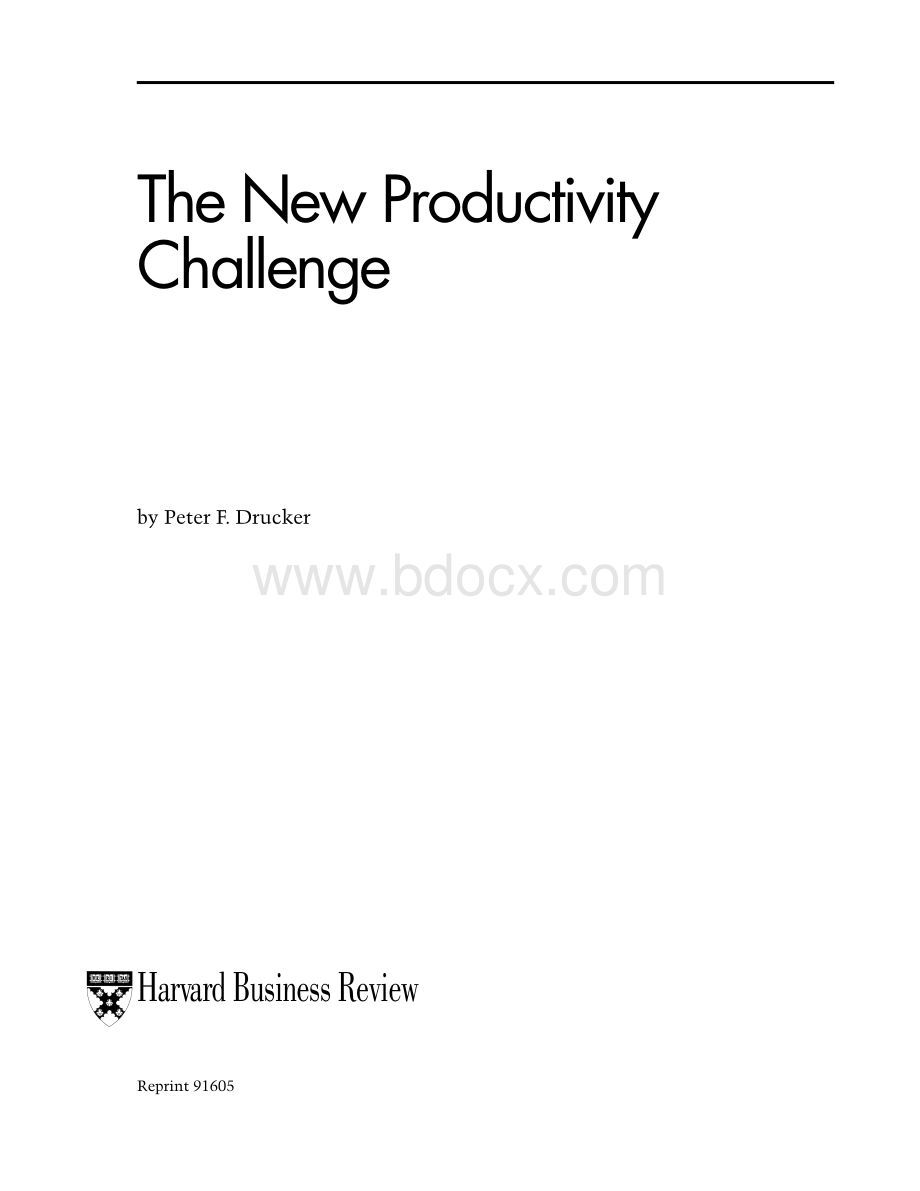TheNewProductivityChallenge.pdf
《TheNewProductivityChallenge.pdf》由会员分享,可在线阅读,更多相关《TheNewProductivityChallenge.pdf(8页珍藏版)》请在冰豆网上搜索。

TheNewProductivityChallengebyPeterF.DruckerReprint91605HarvardBusinessReviewHBRNOVEMBERDECEMBER1991TheNewProductivityChallengePeterF.DruckerThesinglegreatestchallengefacingmanagersinthedevelopedcountriesoftheworldistoraisetheproductivityofknowledgeandser-viceworkers.Thischallenge,whichwilldominatethemanagementagendaforthenextseveraldecades,willultimatelydeterminethecompetitiveperform-anceofcompanies.Evenmoreimportant,itwilldeterminetheveryfabricofsocietyandthequalityoflifeineveryindustrializednation.Forthelast120years,productivityinmakingandmovingthingsinmanufacturing,farming,mining,construction,andtransportationhasrisenindevel-opedcountriesatanannualrateof3%to4%,a45-foldexpansionoverall.Onthisexplosivegrowthrestallthegainsthesenationsandtheircitizenshaveenjoyed:
vastincreasesindisposableincomeandpurchasingpower;ever-wideraccesstoeducationandhealthcare;andtheavailabilityofleisuretime,some-thingknownonlytoaristocratsandthe“idlerich”before1914,wheneveryoneelseworkedatleast3,000hoursayear.(TodayeventheJapaneseworknomorethanabout2,000hourseachyear,whileAmeri-cansaverage1,800hoursandWestGermans1,650.)Nowthesegainsareunraveling,butnotbecauseproductivityinmakingandmovingthingshasfallen.Contrarytopopularbelief,productivityintheseac-tivitiesisstillgoingupatmuchthesamerate.AnditisrisingfullyasmuchintheUnitedStatesasitisinJapanorWestGermany.Indeed,theincreaseinU.S.manufacturingproductivityduringthe1980ssome3.9%ayearwasactuallylargerinabsolutetermsthanthecorrespondingannualincreasesinJapanandGermany,whilethe4%to5%annualriseinU.S.agriculturalproductivityisfarandawaythelargestrecordedanywhereatanytime.Theproductivityrevolutionisoverbecausetherearetoofewpeopleemployedinmakingandmovingthingsfortheirproductivitytobedecisive.Alltold,theyaccountfornomorethanone-fifthoftheworkforceindevelopedeconomies.Only30yearsago,theywerestillanear-majority.EvenJapan,whichisstillmanufacturingintensive,cannolongerexpectin-creasedproductivityinthatsectortosustainitseco-nomicgrowth.Indeed,thegreatmajorityofworkingpeopleinJapanareknowledgeandserviceworkerswithproductivitiesaslowasthoseinanyotherdevelopedcountry.Andwhenfarmersmakeuponly3%oftheemployedpopulation,astheydointheUnitedStates,Japan,andmostofWesternEurope,evenrecordincreasesintheiroutputaddvirtuallynothingtotheircountrysoverallproductivityandwealth.Thechiefeconomicpriorityfordevelopedcoun-tries,therefore,mustbetoraisetheproductivityofknowledgeandservicework.Thecountrythatdoesthisfirstwilldominatethetwenty-firstcenturyeco-nomically.Themostpressingsocialchallengedevel-opedcountriesface,however,willbetoraisethePeterF.DruckeristheClarkeProfessorofSocialScienceandManagementattheClaremontGraduateSchoolinClaremont,Californiaandtheauthorof,mostrecently,ManagingtheNonprofitOrganization(HarperCollins,1990).ThisisMr.Druckerstwenty-nintharticleinHBR.Copyright1991bythePresidentandFellowsofHarvardCollege.Allrightsreserved.productivityofservicework.Unlessthischallengeismet,thedevelopedworldwillfaceincreasingsocialtensions,increasingpolarization,increasingradicali-zation,possiblyevenclasswar.Indevelopedeconomies,opportunitiesforcareersandpromotionaremoreandmorelimitedtopeoplewithadvancedschooling,peoplequalifiedforknowl-edgework.Butthesemenandwomenwillalwaysbeaminority.Theywillalwaysbeoutnumberedbypeoplewholackthequalificationsforanythingbutlow-skilledservicejobspeoplewhointheirsocialpositionarecomparabletothe“proletarians”of100yearsago,thepoorlyeducated,unskilledmasseswhothrongedtheexplodingindustrialcitiesandstreamedintotheirfactories.Intheearly1880s,intelligentobserversofeverypoliticalpersuasionwereobsessedwiththespecterofclasswarbetweentheindustrialproletariatandthebourgeoisie.KarlMarxwashardlyaloneinpredictingthatthe“immiserization”oftheproletariatwouldleadinevitablytorevolution.BenjaminDisraeli,per-hapsthegreatestofthenineteenthcenturyconserva-tives,wasequallypersuadedoftheinevitabilityofclasswar.AndHenryJames,thechroniclerofAmeri-canwealthandEuropeanaristocracy,wassofright-enedbytheprospectthathemadeitthecentralthemeofThePrincessCasamassima,oneofhismosthauntingnovels.Whatdefeatedtheseprophecies,whichseemedeminentlyreasonable,indeedalmostself-evidenttocontemporaries,wastherevolutioninproductivitysetoffbyFrederickW.Taylorin1881,whenhebegantostudythewayacommonlaborershoveledsand.Taylorhimselfworkedinanironfoundryandwasdeeplyshockedbythebitteranimositybetweentheworkersandmanagers.Fearfulthatthishatredwouldultimatelyleadtoclasswar,hesetouttoimprovetheefficiencyofindustrialwork.Andhisefforts,inturn,sparkedtherevolutionthatallowedindustrialwork-erstoearnmiddle-classwagesandachievemiddle-classstatusdespitetheirlackofskillandeducation.By1930,whenaccordingtoMarxtherevolutionoftheproletariatshouldhavebeenafaitaccompli,theproletariathadbecomethebourgeoisie.Nowitistimeforanotherproductivityrevolution.Thistime,however,historyisonourside.Inthepastcentury,wehavelearnedagreatdealaboutproduc-tivityandhowtoraiseitenoughtoknowthatweneedarevolution,enoughtoknowhowtostartone.Knowledgeandserviceworkersrangefromre-searchscientistsandcardiacsurgeonsthroughdraftswomenandstoremanagersto16-year-oldswhofliphamburgersinfast-foodrestaurantsonSaturdayafternoons.Theirranksalsoincludepeoplewhoseworkmakesthem“machineoperators”:
dish-washers,janitors,data-entryoperators.Yetforalltheirdiversityinknowledge,skill,responsibility,socialstatus,andpay,knowledgeandserviceworkersareremarkablyalikeintwocrucialrespects:
whatdoesnotworkinraisingtheirproductivityandwhatdoes.Thefirstthingwehavelearnedanditcameasarudeshockisaboutwhatdoesnotwork.Capitalcannotbesubstitutedforlabor.Norwillnewtech-nologybyitselfgeneratehigherproductivity.Inmak-ingandmovingthings,capitalandtechnologyarefactorsofproduction,tousetheeconomiststerm.Inknowledgeandservicework,theyaretoolsofproduc-tion.Thedifferenceisthatafactorcanreplacelabor,whileatoolmayormaynot.Whethertoolshelpproductivityorharmitdependsonwhatpeopledowiththem,onthepurposetowhichtheyarebeingput,forinstance,orontheskilloftheuser.Thirtyyearsago,forexample,weweresuretheefficiencyofthecomputerwouldleadtomassivereductionsinclericalandofficestaff.Thepromiseofgreaterproductivityledtomassiveinvestmentsindata-pro-cessingequipmentthatnowrivalthoseinmaterials-processingtechnology(thatis,inconventionalma-chinery).Yetofficeandclericalforceshavegrownatamuchfasterratesincetheintroductionofinforma-tiontechnologythaneverbefore.Andtherehasbeenvirtuallynoincreaseintheproductivityofservicework.Hospitalsareatellingexample.Inthelate1940s,theywereentirelylaborintensive,withlittlecapitalinvestmentexceptinbricks,mortar,andbeds.Agoodmanyperfectlyrespectablehospitalshadnoteveninvestedinreadilyavailable,fairlyoldtechnologies:
theyprovidedneitherx-raydepartmentsnorclinicallaboratoriesnorphysicaltherapy.Todayhospitalsarehugelycapitalintensive,withenormoussumsin-vestedinultrasound,bodyscanners,nuclearmag-neticimagers,bloodandtissueanalyzers,cleanrooms,andadozenmorenewtechnologies.Eachpieceofequipmenthasbroughtwithittheneedformorehighlypaidpeoplebuthasnotreducedtheexistingstaffbyasingleperson.(Infact,theworld-wideescalationofhealth-carecostsislargelytheresultofthehospitalshavingbecomealabor-inten-siveandcapital-intensivemonstrosity.)Buthospi-tals,atleast,havesignificantlyincreasedtheirper-formancecapacity.Inotherareasofknowledgeorserviceworkthereareonlyhighercosts,moreinvest-ment,andmorepeople.Massiveincreasesinproductivityaretheonlywayoutofthismorass.AndtheseincreasescanonlycomefromwhatTaylorcalled“workingsmarter.”1Simply,thismeansworkingmoreproductivelywithoutworkingharderorlonger.TheeconomistseescapitalinvestmentasthekeyHARVARDBUSINESSREVIEWNovemberDecember19913toproductivity;thetechnologistgivesstarbillingtonewmachines.Nevertheless,themainforcebehindtheproductivityexplosionhasbeenworkingsmarter.Capitalinvestmentandtechnologywereascopiousinthedevelopedeconomiesduringthefirst100yearsoftheIndustrialRevolutionastheyhavebeeninitssecond100years.Itwasonlywiththeadventofworkingsmarterthatproductivityinmakingandmovingthingstookoffonitsmeteoricrise.Andsoitwillbeforknowledgeandserviceworkwiththisdifference:
inmanufacturing,work-ingsmarterisonlyonekeytoincreasedproductivity.Inknowledgeandservicework,workingsmarteristheonlykey.Whatismore,itisamorecomplexkey,onethatrequireslookingcloselyatworkinwaysthatTaylorneverdreamedof.WhenTaylorstudiedtheshovelingofsand,theonlyquestionthatconcernedhimwas,“Howisitdone?
”Almost50yearslater,whenHarvardsEltonMayosetouttodemolishTaylors“scientificman-agement”andreplaceitwithwhatlatercametobecalled“humanrelations,”hefocusedonthesamequestion.InhisexperimentsatWesternElectricsHawthorneWorks,Mayoasked,“Howcanwiringtelephoneequipmentbestbedone?
”Thepointisthatinmakingandmovingthings,thetaskisalwaystakenforgranted.Inknowledgeandservicework,however,thefirstquestionsinincreasingproductivityandworkingsmarterhavetobe,“Whatisthetask?
Whatarewetryingtoaccomplish?
Whydoitatall?
”Theeasiest,butperhapsa